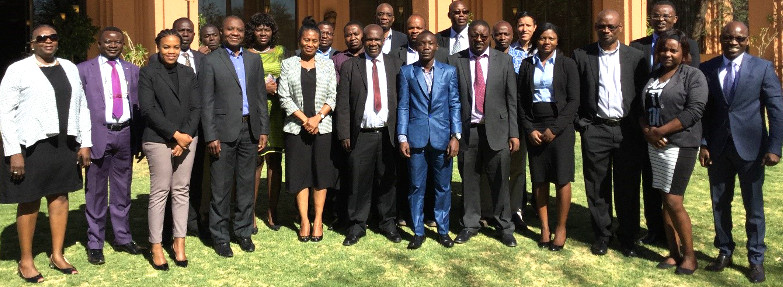 The Inception meeting and NeedFinding workshop attracted participants from the following SGCs: Burkina Faso, Ghana, Malawi, Namibia, Uganda, Senegal, Zambia and Zimbabwe. Resource persons came from the following institutions: African Union Commission,
The Inception meeting and NeedFinding workshop attracted participants from the following SGCs: Burkina Faso, Ghana, Malawi, Namibia, Uganda, Senegal, Zambia and Zimbabwe. Resource persons came from the following institutions: African Union Commission,
New Partnership for Africa’s Development (NEPAD) Agency, United Nations Economic Commission for Africa (ECA), and SARIMA. The following countries did not send representatives primarily due to short notice that was given: Kenya, Tanzania, Ivory Coast, Ethiopia, Rwanda and Mozambique.
The SGCI-Theme #2 Inception Meeting was held on 3rd October 2016. The meeting was opened by Dr. Mvula, CEO of the National Commission for Research, Science and Technology (Namibia). In his remarks he welcomed delegates to Namibia. He observed that Africa had common problems in science, technology and innovation (STI). He further indicated that the Science, Technology and Innovation Strategy for Africa (STISA 2024) represents a common approach to tackling problems besetting Africa in the area of STI. Through STISA Africa has committed to allocate 1% of GDP to Research and Development (R&D). He finally underscored the need for SGCs to come up with strategies to ensure that the resources are used for the intended purpose.
1.2 Presentations
The following two presentations were made during the Inception Meeting:
The Objective of Theme #2 was to “Strengthen the abilities of SGCs to design and monitor research programmes, and formulate and implement policies based on the use of robust science, technology and innovation (STI) indicators”. Members were informed that SGCI Theme #2 should be seen as a progression from the African Science, Technology and Innovation Indicators Initiative (ASTIII) which was implemented by NEPAD Agency. During ASTIII Phases 1&2, the focus was on knowledge generation. During Phase 3 the focus was on sharing experiences (i.e. connecting the dots of knowledge from phase 1&2). On the other hand, SGCI Theme #2 focuses on creativity in order to link indicators with development plans or to establish how indicators influence decision making.
Participants were oriented on the Implementation Plan. It was noted that the NEPAD Agency was contracted to provide technical support to strengthen the ability of participating Science Granting Councils to realise the foregoing objective. Under this objective, NEPAD Agency plans to use continental frameworks such as STISA 2024 Implementation Framework, develop norms and standards to help assess, report and learn from success or failure, develop a “Guide to Good Practices for Designing and Monitoring of National Research Programmes”, and use Impact Oriented Monitoring (IOM) methodology to design, monitor and evaluate projects or programmes funded by SGCs for impact.
2.1 Introduction
The NeedFinding Workshop was held from 4th to 7th October 2016. The workshop was aimed at sharing experiences among SGCs and understanding the meaning of NeedFinding.
2.2 Presentations
The following presentations were made:
2.2.1 Science Technology and Innovation Strategy for Africa (STISA) 2014 by Dr. Monica Idinoba of African Union Commission
The presenter highlighted historical background and priorities of STISA 2014, and the need to align policies and activities of SGCs to STISA and AU Agenda 2063. The historical background included early statement of late Kwame Nkrumar on science and technology, the AU Lagos Plan of Action of 1980 that set a target of 1% of GDP allocation to S&T, the AU Africa’s Science and Technology Consolidated Plan of Action (CPA) which focussed on STI capacity building, knowledge production and technological innovation. The priorities of STISA 2024 are: eradicate hunger and ensure food and nutrition security, prevent and control diseases and ensure well-being, communication, protect our space, live together-build the society, and create wealth.
2.2.3 National (S&T) Innovation Systems by representatives of Namibia, Malawi, Ghana, Zimbabwe, Zambia, Burkina Faso, Senegal, and Uganda
The common feature of all presentations by SGCs were: existence S&T policies and legislations, provision for an S&T fund in both policies and legislations, institutional arrangements that include parliamentary committees, cabinet committees, boards, board committees and secretariat. All the SGCs apart from Namibia said they were poorly funded. Most SGCs are aligned with Office of President and Cabinet or Ministries of Higher Education. It was pleasing to learn that the government of Namibia was providing funding for implementation of their S&T program.
2.3.4 NeedFinding by Dr. Tichaona Mangwende
The take-home message from this presentation was as follows: